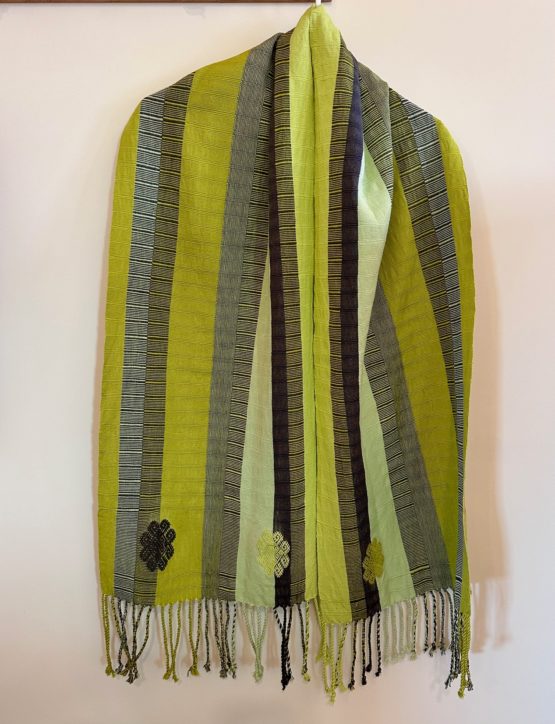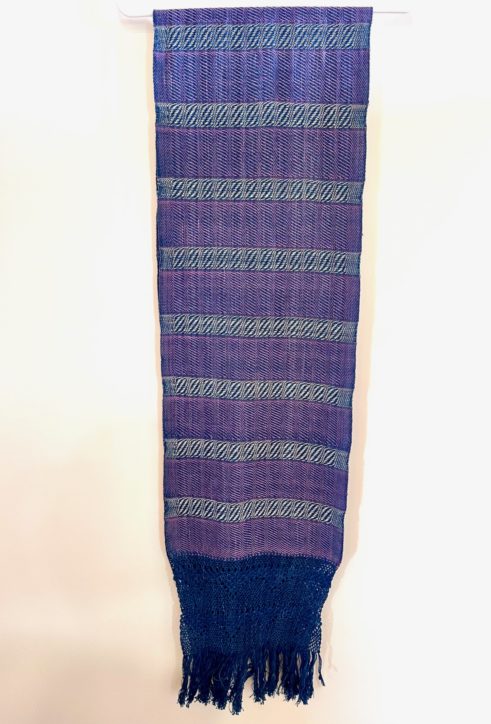Ten of us traveled by van for almost three hours to get to the Sierra Norte mountain village of San Pedro Cajonos where silk worms are cultivated, their cocoons spun and then woven on back strap looms into glorious silk garments colored with natural dyes! At the end, were were at almost 7,000 feet altitude, rising 2,000 feet above the Oaxaca valley. Once a dirt donkey path, the road meanders and winds through pine and oak forests, branches dripping with moss and bromeliads.



The hills are creviced with rock outcroppings, rivulets become waterfalls, moss and ferns form natural rock gardens. It’s slow going to avoid pot holes and maneuver the switchbacks as we climb, passing through the eco-village of Cuajamaloyos where zip-lining, hiking and wild mushroom hunting attract tourists.

Our destination holds the promise of meeting Moises Martinez Velasco and his family, known as one of the finest silk weavers of Mexico. The state of Oaxaca and Mexico’s government have invested in building a stunning silk sanctuary, a contemporary concrete and glass structure perched on a hillside with stunning views, to research and promote the development of silk textiles. 1500 people live in San Pedro Cajonos. Their houses and workshops are built into the sides of the mountain, usually on several levels, making it necessary to move vertically from one room to another. Imagine bedrooms on the first plane, then the workshop above, then kitchen and dining/living rooms on the top floor. Stairways connect each level. Did I say the views are spectacular, lush and green.

We meet Moises at his home and he first takes us to meet his two elderly aunts, age 74 and 75, who practice the art of weaving ixtle — agave fiber — into bags that are use by campesinos to carry their lunch into the corn fields. This is a dying art. There are only 10 people remaining in the village who do this work; once 400 people made these ixtle bags. The agave leaves are stripped, soaked, pounded to soften it, and then spun into 2-ply strands. The aunts learned from their parents, who learned from their parents, and those who came before them.
This is a Zapotec community, and they have been living here since the decline of Monte Alban in 1100-1300 AD. The dialect they speak is different from the language of the Oaxaca valley. Spanish is the common denominator, although the older people still cling to their native tongue.

Then, we visit Moises’ sister, Ever, who cultivates the worms. She has one room of her house dedicated to raising the worms from eggs. Each butterfly will lay 300 eggs. It seems there are thousands of little black specks deposited on butcher paper, and there are — 10,000 eggs which will survive for one year. Ever will use what she needs, removing the eggs and then folding up the remaining ones to sleep until the next time she needs them. And, of course, another family member raises mulberry leaves and the fields below the community’s Silk Sanctuary are filled with 500 mulberry trees. The goal is to grow the orchard to 1,500 trees.



The worms are voracious, eating entire leaves in succession throughout the day. Feeding them is a full-time endeavor. April and August are when the eggs mature into caterpillars. Controlled timing helps to ensure there are enough mulberry leaves to feed them. As the worms grow, they consume more until they are ready to spin the silk cocoon from the saliva of their mouth. At this stage they no longer eat, and prefer to seclude themselves among the leaves and branches of oak trees.


Silk is spun using a mechanized Japanese spinning wheel. There are 15 members in Moises’ cooperative. Four people are spinning specialists. The rest weave the cloth and make the hand-knotted fringes. It takes one day to wash the silk, another day to mordant the silk, a third day to dye the silk, and then two more weeks to weave on the back strap loom, sew the wefts of cloth together using a complex needle embroidery, and then to make the fringes — working five hours a day. The weaving technique here is plain weave.


Two types of worms are cultivated, one that produces the wild yellow cocoon that has been in existence in Oaxaca for over 450 years, and the white bombyx cocoon. The wild one has adapted to the environment and survives diseases, laying its eggs and then flying away. The one that produces the white cocoon dies after producing eggs.



At the Silk Sanctuary research center, PhD educated biologists and agronomy engineers study the life cycle through microscopes to determine if the eggs are healthy and why. Mostly, they are studying the yellow cocoons which are from the wild species. One engineer has training in Japanese silk cultivation. They continually check the humidity levels and room temperatures to understand the optimum time for egg development. This is the only center for silk cultivation and production in Mexico.
Silk blusas, hupiles, bufandas (scarves), and rebozos (shawls) from San Pedro Cajonos can be found at the Oaxaca Textile Museum shop, and when there are special pop-up sales in the city that we call expoventas. Of course, you can make your way to San Pedro Cajonos on your own, though this visit was a part of our Summer Textile Mountain Tour.



Note: We still have spaces open for our Day of the Dead Culture Tour, October 29 to November 4, and for our one-day Day of the Dead Tour on October 31 to explore the deeper meaning of this pre-Hispanic celebration.
















